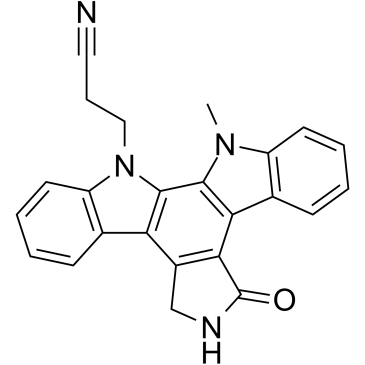136194-77-9
| Name | Gö 6976 |
|---|---|
| Synonyms |
Go-6976
MFCD00236434 Go 6976,Solution 5,6,7,13-tetrahydro-13-methyl-5-oxo-12H-Indolo(2,3-a)pyrrolo(3,4-c)carbazole-12-propanenitrile Goe 6976 3-(13-Methyl-5-oxo-5,6,7,13-tetrahydro-12H-indolo[2,3-a]pyrrolo[3,4-c]carbazol-12-yl)propanenitrile 12H-Indolo[2,3-a]pyrrolo[3,4-c]carbazole-12-propanenitrile, 5,6,7,13-tetrahydro-13-methyl-5-oxo- |
| Description | Go6976 is a Protein Kinase C (PKC) inhibitor, with an IC50 of 20 nM. |
|---|---|
| Related Catalog | |
| Target |
IC50: 20 nM (PKC)[1]. |
| In Vitro | Go6976 is a potent inhibitor of PKC in vitro (IC50 is 20 nM. This compound is structurally related to staurosporine, which is the most potent PKC inhibitor[1]. UCN-01 is originally identified as a PKC inhibitor. Surprisingly, Go6976 is found to abrogate S and G2 arrest. Dose-response studies reveal that 30 nM Go6976 is sufficient to cause abrogation of S-phase arrest in 6 h and abrogation of G2 arrest followed by lethal mitosis in 24 h. Incubation of cells with 100 nM Go6976 is sufficient to cause complete abrogation of S and G2 arrest at 6 and 24 h, respectively, which is only slightly less potent than in bovine serum. Incubation of cells with UCN-01 or Go6976 alone do not decrease viability compared with control at the concentrations used. Incubation of cells with 5 ng/mL SN38 result in cytostasis, and addition of 50 nM UCN-01 or 100 nM Go6976 to arrested MDA-MB-231 cells cause a dramatic decrease in viable cell number by 96 h[2]. |
| Cell Assay | Logarithmically growing cells are incubated with or without 5 ng/mL SN38 for 24 h and then incubated with or without 50 nM UCN-01 or 100 nM Go6976 for the following 24 h. MDA-MB-231 (500 cells) or MCF-10A (1000 cells) are plated in 100 μL in each well of a 96-well plate. The following day, drugs are added at the desired concentrations (Go6976: 1, 3, 10, 30, 100 nM) and with the required schedule to replicate wells (a minimum of 4 wells/concentration). Drugs are removed, and plates are rinsed and then incubated for an additional 6 days. Inhibition of growth was then assessed on the basis of DNA content. Briefly, the media are removed, and attached cells are washed in 0.25×PBS, followed by the addition of 100 μL of H2O. Cells are lysed by freeze/thawing the plates. Hoechst 33258 is added in high-salt buffer, cells are incubated for 2 h, and fluorescence is measured[2]. |
| References |
| Density | 1.4±0.1 g/cm3 |
|---|---|
| Boiling Point | 652.3±55.0 °C at 760 mmHg |
| Molecular Formula | C24H18N4O |
| Molecular Weight | 378.426 |
| Flash Point | 348.3±31.5 °C |
| Exact Mass | 378.148071 |
| PSA | 62.75000 |
| LogP | 3.48 |
| Vapour Pressure | 0.0±2.0 mmHg at 25°C |
| Index of Refraction | 1.774 |
| Storage condition | −20°C |
| Safety Phrases | S22-S24/25 |
|---|
